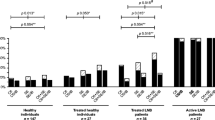Abstract
Although two-tier testing is standard practice in both the United States and Europe for the serologic diagnosis of Lyme borreliosis (LB), the test kits generally differ. The purpose of this study was to determine if the testing used in the United States will detect LB acquired in Europe and vice versa. Testing was performed on a convenience sample of archived sera from 40 LB patients from Austria and 39 from the United States, using first- and second-tier test kits from both the United States and Europe. The sensitivity of four first-tier tests from Europe and two first-tier tests from the United States was similar. Thus, two-tier testing was compared to the C6 ELISA as the first-tier test, since it is licensed in both the United States and Europe. The sensitivity of C6 two-tier testing with US assays was 9/40 (22.5 % [95 % CI 10.8–38.5 %]) for detection of LB acquired in Europe, and just 20.0 % (95 % CI 2.5–55.6 %) in the ten European patients with neurologic involvement. These results differed significantly from the sensitivity of European C6 two-tier testing that was 70.0 % (95 % CI 53.5–83.4 %) overall (p < 0.001) and 90.0 % (95 % CI 55.5–99.7 %) for the European patients with neurologic manifestations specifically (p = 0.016). In contrast, the sensitivity of European and US C6 two-tier testing was similar for detection of LB acquired in the United States. Two-tier serologic testing with the US test kits may be unsatisfactory for detection of LB acquired in Europe. First-tier testing with an assay such as the C6 ELISA should be considered as a stand-alone diagnostic strategy in such cases.

Similar content being viewed by others
References
Hubalek Z (2009) Epidemiology of Lyme borreliosis. Curr Probl Dermatol 37:31–50. doi:10.1159/000213069
Stanek G, Wormser GP, Gray J, Strle F (2012) Lyme borreliosis. Lancet 379:461–473. doi:10.1016/S0140-6736(11)60103-7
Branda JA, Strle F, Strle K, Sikand N, Ferraro MJ, Steere AC (2013) Performance of United States serologic assays in the diagnosis of Lyme borreliosis acquired in Europe. Clin Infect Dis 57:333–340
UNWTO tourism highlights 2013 edition. http://www.austriatourism.com/wp-content/uploads/2013/09/2013e_tourism-highlights-2013_welt_unwto.pdf (accessed 10/10/12)
Steere AC, McHugh G, Damle N, Sikand VK (2008) Prospective study of serologic tests for Lyme disease. Clin Infect Dis 47:188–195. doi:10.1086/589242
Bacon RM, Biggerstaff BJ, Schriefer ME et al (2003) Serodiagnosis of Lyme disease by kinetic enzyme-linked immunosorbent assay using recombinant VlsE1 or peptide antigens of Borrelia burgdorferi compared with 2-tiered testing using whole cell lysates. J Infect Dis 187:1187–1199
Marangoni A, Moroni A, Accardo S, Cevenini R (2008) Borrelia burgdorferi VlsE antigen for the serological diagnosis of Lyme borreliosis. Eur J Clin Microbiol Infect Dis 27:349–354. doi:10.1007/s10096-007-0445-7
Tjernberg I, Kruger G, Eliasson I (2007) C6 peptide ELISA test in the serodiagnosis of Lyme borreliosis in Sweden. Eur J Clin Microbiol Infect Dis 26:37–42
Branda JA, Linskey K, Kim YA, Steere AC, Ferraro MJ (2011) Two-tiered antibody testing for Lyme disease with use of 2 enzyme immunoassays, a whole-cell sonicate enzyme immunoassay followed by a VlsE C6 peptide enzyme immunoassay. Clin Infect Dis 53:541–547. doi:10.1093/cid/cir464
Crother TR, Champion CI, Wu X-Y, Blanco DR, Miller JN, Lovett MA (2003) Antigenic composition of Borrelia burgdorferi during infection of SCID mice. Infect Immun 71:3419–3428
Zhang JR, Hardham JM, Barbour AG, Norris SJ (1997) Antigenic variation in Lyme disease borreliae by promiscuous recombination of VMP-like sequence cassettes. Cell 89:275–285
Centers for Disease Control and Prevention (1995) Recommendations for test performance and interpretation from the second national conference on serologic diagnosis of Lyme disease. MMWR Morb Mortal Wkly Rep 44:590–591
Busson L, Reynders M, den Wijngaert SV et al (2012) Evaluation of commercial screening tests and blot assays for the diagnosis of Lyme borreliosis. Diagn Microbiol Infect Dis 73:246–251. doi:10.1016/j.diagmicrobio
Acknowledgments
The authors thank Lisa Giarratano, Shantale Williams, Mary Cox and Brigitte Zinke for their assistance. GPW: Research grants from CDC, NIH, Immunetics, Inc., BioRad, DiaSorin, Inc. and BioMerieux; Equity in Abbott; Expert witness in malpractice cases involving Lyme borreliosis; Unpaid board member American Lyme Disease Foundation; Expert witness regarding Lyme disease in a disciplinary action for the Missouri Board of Registration for the Healing Arts; consultant to Baxter regarding Lyme vaccines. FS, GPW and GS are members of the ESCMID study group on Lyme borreliosis, ESGBOR. Funding for this study was provided to AT and NS by the Education and Research Foundation Medical Scholars Program of the Infectious Diseases Society of America.
Author information
Authors and Affiliations
Corresponding authors
Rights and permissions
About this article
Cite this article
Wormser, G.P., Tang, A.T., Schimmoeller, N.R. et al. Utility of serodiagnostics designed for use in the United States for detection of Lyme borreliosis acquired in Europe and vice versa. Med Microbiol Immunol 203, 65–71 (2014). https://doi.org/10.1007/s00430-013-0315-0
Received:
Accepted:
Published:
Issue Date:
DOI: https://doi.org/10.1007/s00430-013-0315-0




